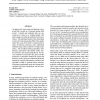Free Online Productivity Tools
i2Speak
i2Symbol
i2OCR
iTex2Img
iWeb2Print
iWeb2Shot
i2Type
iPdf2Split
iPdf2Merge
i2Bopomofo
i2Arabic
i2Style
i2Image
i2PDF
iLatex2Rtf
Sci2ools
ICML
2003
IEEE
2003
IEEE
Semi-Supervised Learning Using Gaussian Fields and Harmonic Functions
An approach to semi-supervised learning is proposed that is based on a Gaussian random field model. Labeled and unlabeled data are represented as vertices in a weighted graph, with edge weights encoding the similarity between instances. The learning problem is then formulated in terms of a Gaussian random field on this graph, where the mean of the field is characterized in terms of harmonic functions, and is efficiently obtained using matrix methods or belief propagation. The resulting learning algorithms have intimate connections with random walks, electric networks, and spectral graph theory. We discuss methods to incorporate class priors and the predictions of classifiers obtained by supervised learning. We also propose a method of parameter learning by entropy minimization, and show the algorithm's ability to perform feature selection. Promising experimental results are presented for synthetic data, digit classification, and text classification tasks.
| Added | 17 Nov 2009 |
| Updated | 17 Nov 2009 |
| Type | Conference |
| Year | 2003 |
| Where | ICML |
| Authors | Xiaojin Zhu, Zoubin Ghahramani, John D. Lafferty |
Comments (0)

